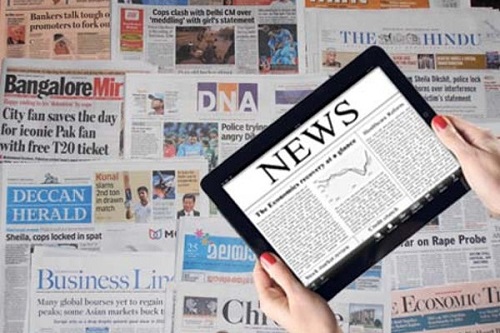By
Tom Arms
The world’s media is rapidly changing. And as it changes it plays a sad role in helping to divide society. The irony is that the press in all its forms has never been freer, more competitive and offered a greater array of opinion and facts.
The number of traditional print platforms has markedly declined, and the ones that remain are only just staying in business with slashed circulation figures.
The print business, however is being rapidly replaced with news websites. As of the start of this year there were an estimated 100 million news websites worldwide. This compares to about 18,000 daily newspapers.
To understand the impact of these figures it is important to realise a basic truism about the vast majority of the media. It exists to make a profit. There are, of course, exceptions to this rule such as state-owned broadcasters or magazines and newspapers published by pressure groups.
The benefit of a profit-oriented media is that profits keep the press free. Without profits journalists quickly become mouthpieces for whomever is stumping up the cash to pay their bills. Alternatively, they become more outrageous in their news coverage in a desperate bid to maintain circulation figures. This is often as true of what is referred to the mainstream media, quality or broadsheet newspapers as it is of the tabloid scandal sheets. Desperate times induce desperate measures.
Of course, it can be argued that the internet is also an opportunity for the traditional media. Before it came along newspapers were restricted to how far their delivery vans could travel. The New York Times was sold mainly in the greater New York area, the New Indian Express didn’t travel far beyond the boundaries of Chennai and The Glasgow Herald was read almost exclusively in Scotland.
The Worldwide Web provided a virtually free global distribution network. But who were the readers? This is an important question for newspaper editors. The identity of the readership determines the nature of the advertising and the direction of the editorial policy. “Know Thy Reader” is engraved on almost every editor’s heart.
Since 1851 the New York Times reader had been clearly identified as—first and foremost—a New Yorker. If the New York Times was going to succeed as a global product it had to identify a new market to represent, and rejig its editorial policies to reflect the interests of that market. It decided to become the world’s liberal newspaper.
It was an easy decision. The newspaper has a long history of espousing liberal causes and anti-establishment investigative journalism. But it has become even more so, at times, stridently so. The result is their web circulation among the world’s liberals has rapidly climbed, but they have been shunned by conservative-minded readers who had looked to the New York Times for a dispassionate report on the day’s news.
Previously the conservatives turned a blind eye towards the paper’s liberal bias. Its place in the media firmament made it required reading for all and sundry. But the internet—with its low entry threshold and global distribution—also enabled conservative websites to spring up to claim a conservative market which felt unrepresented.
And the more outrageously conservative these sites were the greater the attraction for their followers. Enter the fake news outlets. As of the start of this year there were some 60 identifiable fake news websites in the US alone—almost all of them extreme right wing. One of the most notorious is Alex Jones’ Infowars which has claimed that millions voted illegally in the 2016 presidential elections, the mass shootings at Sandy Hook Elementary School was a hoax and that the Democratic Party was running a sex slave ring out of a Washington pizza restaurant.
Jestin Coler, who owns several fake news websites, said: “When it comes to fake stuff you really want it to be red meat. It doesn’t have to be offensive. It doesn’t have to be outrageous. It doesn’t have to be anything other than giving them what they already wanted to hear.”
And that is one of the main reasons they believe it. They want to believe it. It reinforces preconceived fears and opinions, just as the increasingly liberal traditional press reinforces the beliefs of the liberal-minded market. It is not surprising that society is increasingly divided.
Tom Arms is the editor of LookAheadnews.com and the former CEO of the international news agency Future Events News Service. Sign up now for the weekly diary of world news events.
LookAhead Radio World Report for week commencing 13 November 2017:
Tom Arms
I am a journalist, entrepreneur and historian with extensive experience in print, web and broadcast journalism. I started as a diplomatic correspondent, wrote several books (The Falklands Crisis, World Elections On File and the Encyclopedia of the Cold War), and then in 1987 started my own business (Future Events News Service, www.fensinformation.com) which over 25 years established itself as the world and UK media’s diary. Our strapline was: “We set the world’s news agenda.” I sold FENS in December 2012 but retained the exclusive broadcast rights to all of FENS data. To exploit these rights I set up LookAhead TV which produces unique programmes which “Broadcasts Tomorrow Today” so that viewers can “Plan to Participate.” LookAhead has appeared regularly on Vox Africa, Radio Tatras International, The Conversation and Voice of Africa Radio.
In addition to being a syndicated broadcaster and columnist on global affairs, Tom is also available for speaking engagements and can be contacted on Twitter, Linkedin and email: [email protected].



No Comments Yet!
You can be first to comment this post!